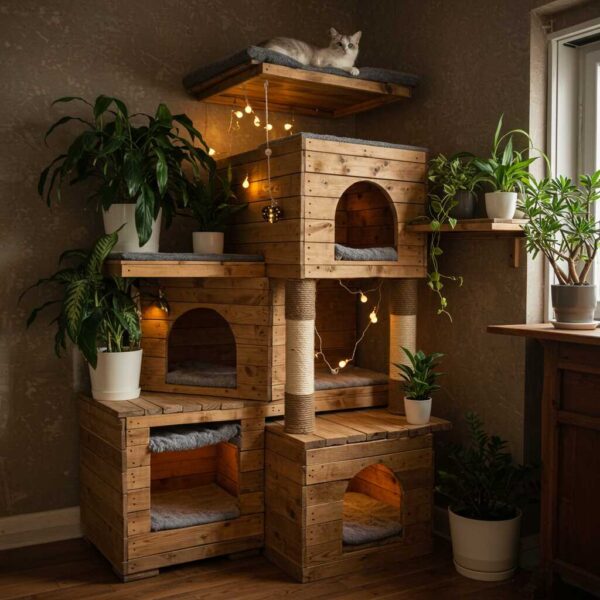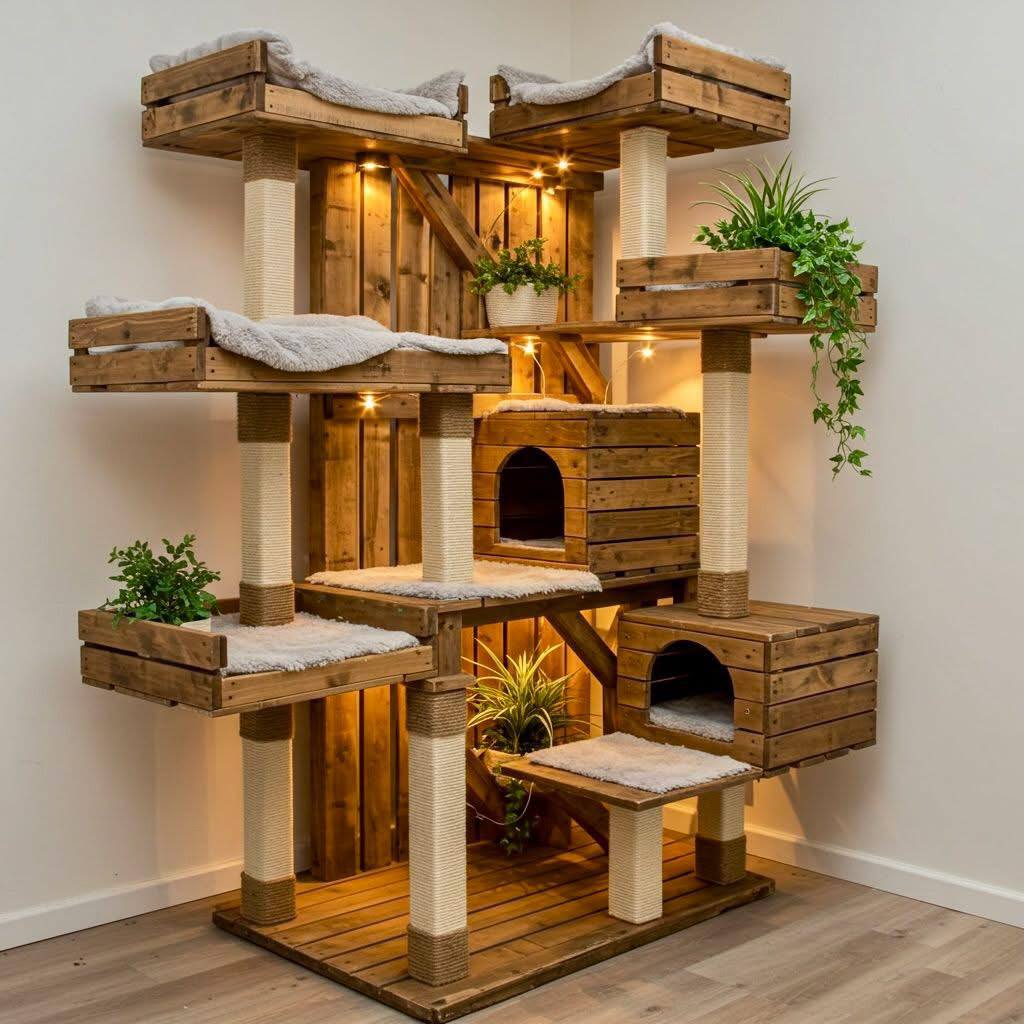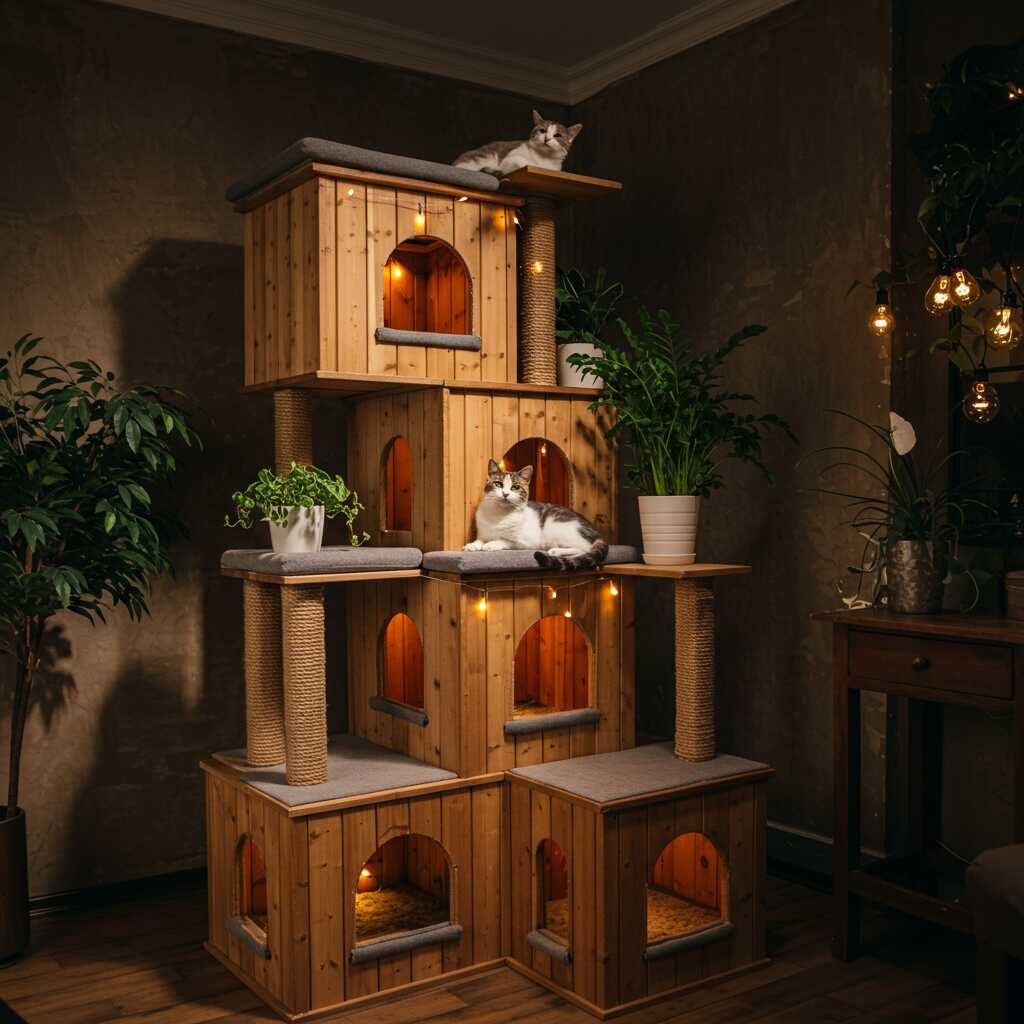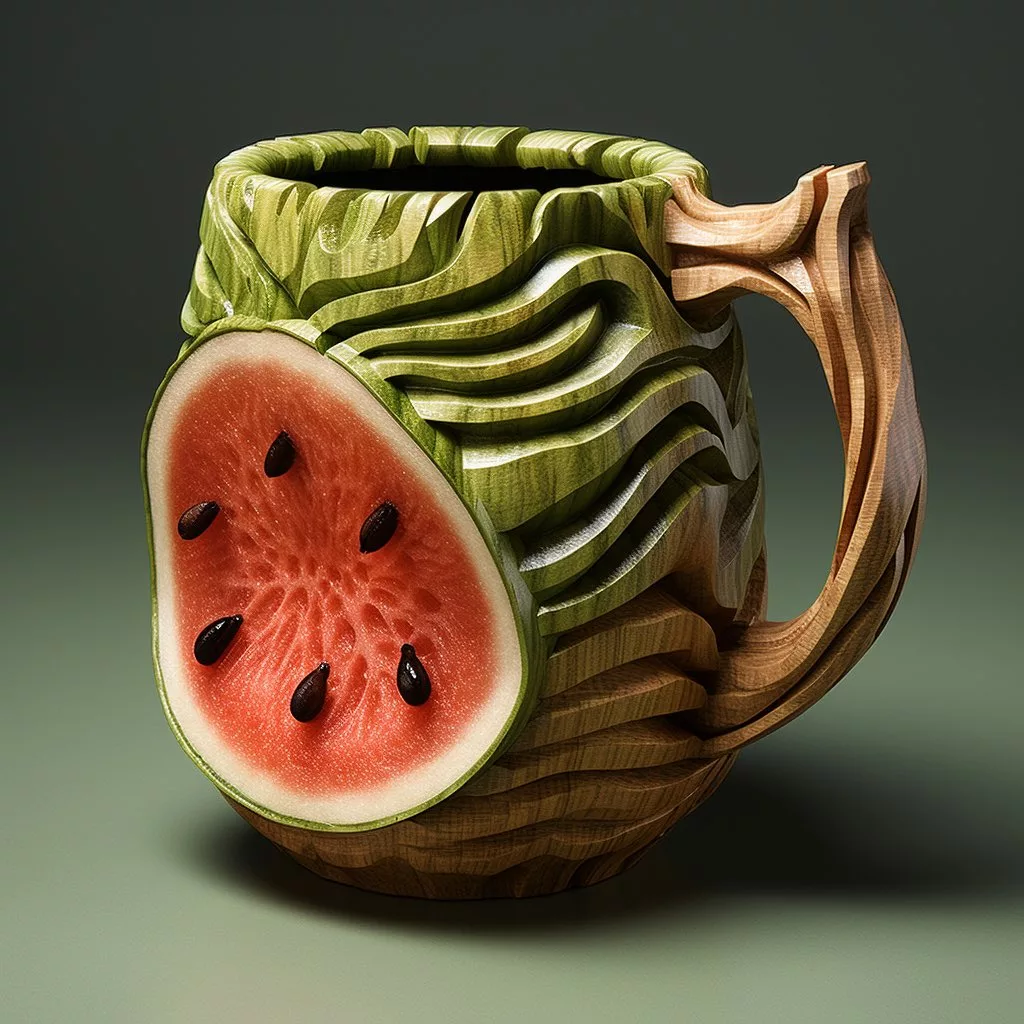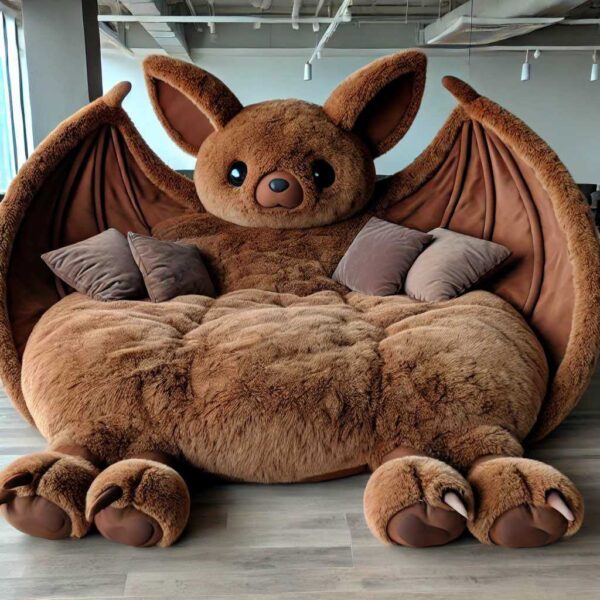Contents
Crafting a Cat Tree Made From Pallet Wood
In recent years, the concept of sustainability has permeated every aspect of our lives, from fashion to home decor. One area where this trend has particularly flourished is in pet care, with cat owners increasingly seeking eco-friendly and budget-conscious ways to provide their feline companions with enriching environments. A “Cat Tree Made From Pallet Wood” perfectly embodies this ethos, offering a creative solution that combines functionality, aesthetics, and environmental responsibility.
Pallet wood, often discarded or overlooked, is an incredibly versatile material for crafting DIY projects. Its durability and natural texture make it ideal for creating sturdy structures like cat trees. Moreover, repurposing pallets reduces waste and minimizes the need for purchasing new materials, aligning with sustainable living practices. For cat owners, building a cat tree from recycled pallet wood not only provides a cost-effective alternative to store-bought options but also allows for complete customization. You can tailor the design to suit your cat’s preferences—whether they love lounging, climbing, or scratching—and ensure it complements your home’s interior.
This article delves into the best DIY cat tree ideas using recycled pallet wood, exploring how you can transform humble wooden pallets into a luxurious haven for your furry friend. Whether you’re a seasoned DIY enthusiast or a beginner looking for a rewarding project, these ideas will inspire you to create something both practical and beautiful. By the end of this guide, you’ll have all the tools and knowledge needed to embark on your own pallet wood cat tree journey.
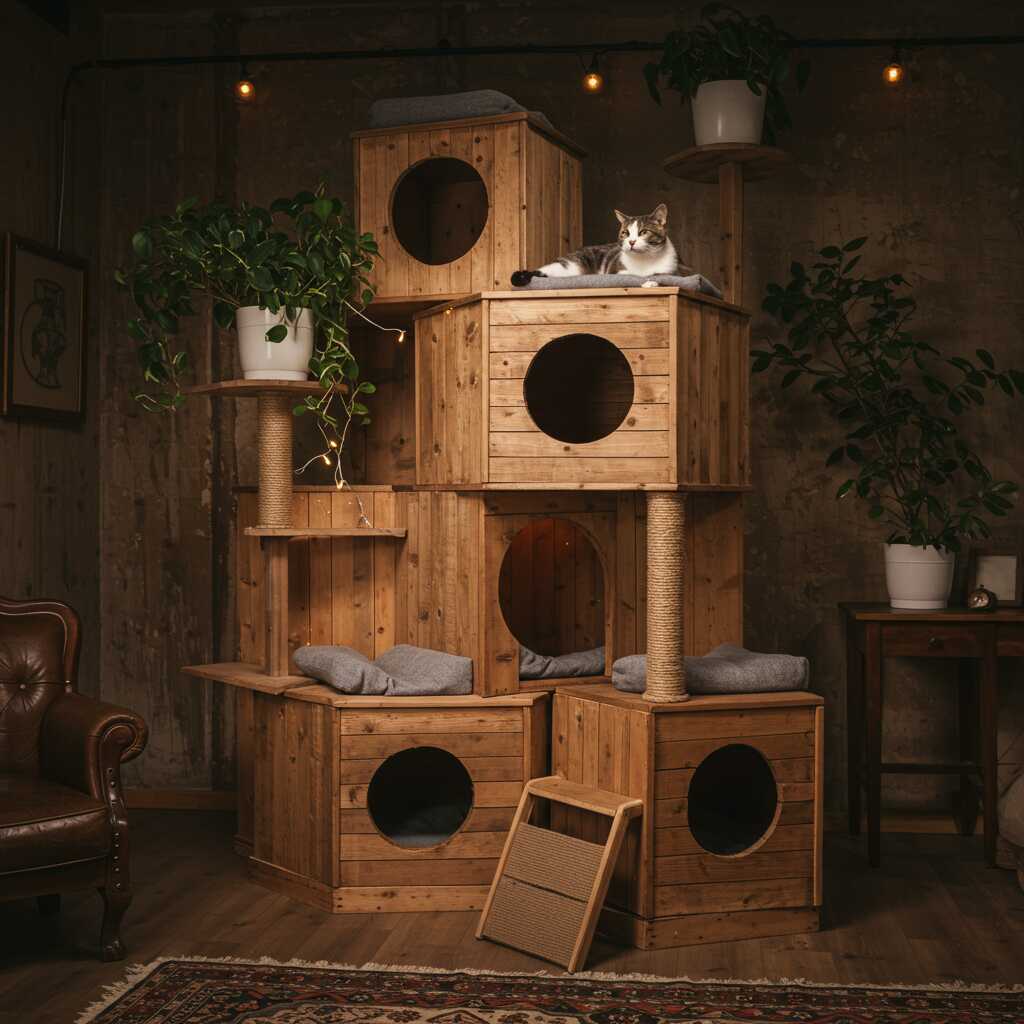
Why Choose Pallet Wood for Your Cat Tree?
Sustainability Meets Functionality
One of the most compelling reasons to use pallet wood for crafting a “Cat Tree Made From Pallet Wood” is its inherent sustainability. Every year, millions of wooden pallets are discarded after serving their primary purpose in shipping and logistics. By salvaging these pallets, you contribute to reducing landfill waste and conserving resources. Additionally, pallet wood is typically untreated or lightly treated, making it safe for pets when properly prepared. This contrasts sharply with some commercially available cat trees that may contain harmful chemicals or synthetic materials.
Beyond its environmental benefits, pallet wood offers exceptional durability. Designed to withstand heavy loads during transportation, pallets are built to last. When disassembled and repurposed, the planks retain their strength, ensuring your cat tree can endure years of playful antics without losing structural integrity. Furthermore, the rough texture of pallet wood provides an excellent surface for cats to scratch, satisfying their natural instincts while saving your furniture from damage.
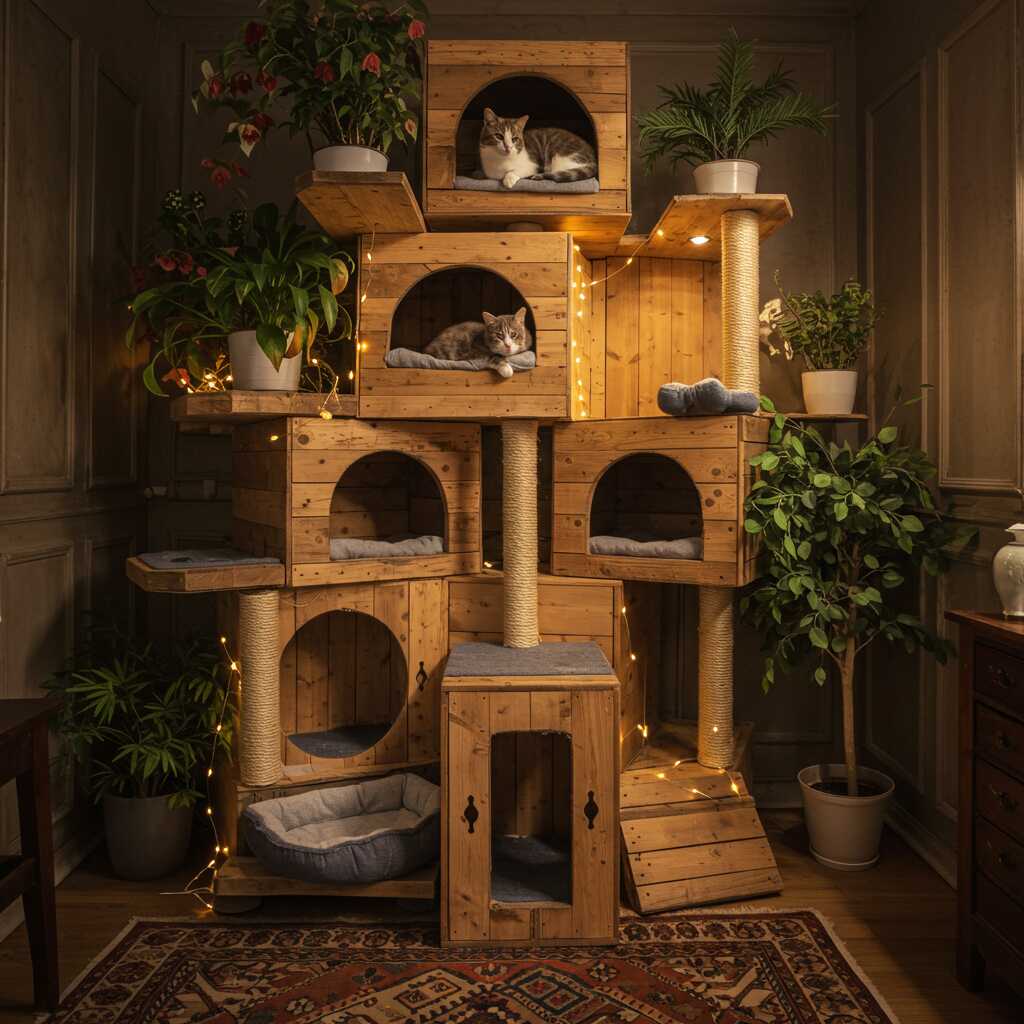
Step-by-Step Guide to Building a Basic Cat Tree Made From Pallet Wood
Gathering Materials and Tools
Before diving into construction, gather the necessary materials and tools. For a basic cat tree, you’ll need:
- Pallet wood: Look for clean, undamaged pallets labeled “HT” (heat-treated) rather than “MB” (methyl bromide-treated), as the latter contains harmful chemicals.
- Screws and nails: Use corrosion-resistant fasteners to ensure longevity.
- Carpet scraps or sisal rope: These add comfort and scratching surfaces.
- Staple gun: For attaching carpet or fabric securely.
- Drill and saw: Essential for cutting and assembling the wood.
- Sandpaper: To smooth rough edges and prevent splinters.
Optional additions include non-toxic paint or stain for finishing touches, as well as cushions or pillows for added coziness.
Designing Your Cat Tree
Start by sketching a simple blueprint of your desired cat tree. Consider factors such as available space, your cat’s size, and their behavioral tendencies. A basic design might include:
- Base platform: A wide, stable foundation to support the entire structure.
- Vertical posts: Tall columns wrapped in sisal rope for climbing and scratching.
- Perches: Horizontal platforms covered in carpet or fabric for lounging.
- Hammock or cubby: An optional feature for relaxation or play.
Construction Process
- Disassemble the pallets: Carefully remove nails or staples and separate the planks. Sand each piece thoroughly to eliminate sharp edges.
- Assemble the base: Cut four pieces of wood to form a rectangular frame and secure them together using screws. Reinforce the base with additional crossbeams for stability.
- Attach vertical posts: Screw the posts into the corners of the base. Wrap them tightly with sisal rope, securing the ends with glue or staples.
- Add perches: Cut plywood or pallet planks to size and attach them to the posts at varying heights. Cover the tops with carpet or fabric, stapling it underneath for a neat finish.
- Include extras: If desired, install a hammock between two posts or create a cubby by attaching walls around one of the lower platforms.
- Final touches: Sand any remaining rough areas, apply a non-toxic sealant, and let the structure dry completely before introducing it to your cat.
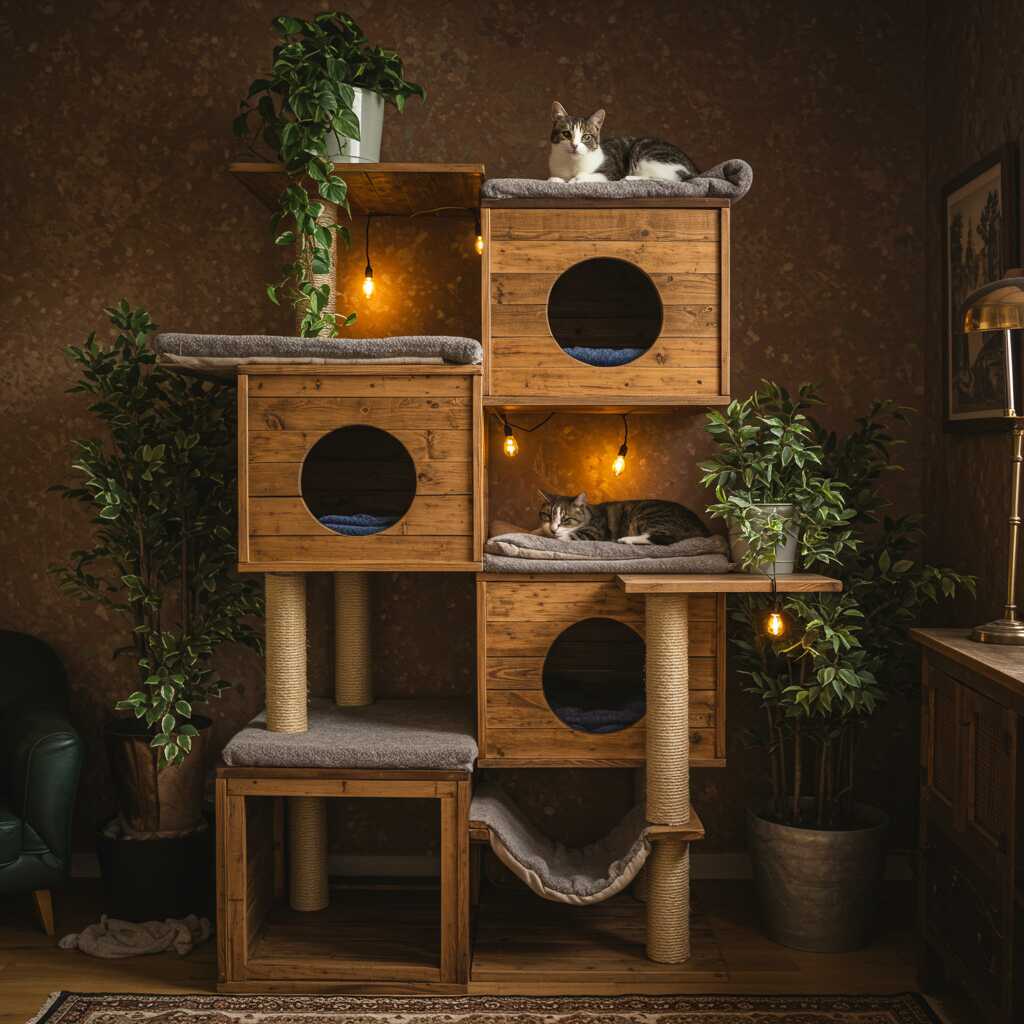
Creative Variations and Advanced Designs
Multi-Level Cat Condos
For households with multiple cats or adventurous felines, consider building a multi-level cat condo. This design incorporates several tiers connected by ramps or ladders, providing ample opportunities for exploration and exercise. Add features like tunnels, dangling toys, or even a window perch to keep your cats entertained.
Wall-Mounted Cat Trees
If floor space is limited, a wall-mounted cat tree is an innovative solution. Secure shelves made from pallet wood to the wall at staggered heights, creating a vertical playground for your cat. Enhance the setup with hanging bridges or suspended hammocks for added flair.
Themed Cat Trees
Unleash your creativity by designing a themed cat tree. For example, a rustic farmhouse-style tree could feature unpainted wood and burlap accents, while a jungle-themed version might include faux vines and leopard-print fabrics. These personalized touches not only delight your cat but also serve as eye-catching pieces of home decor.
Tips for Maintaining Your Pallet Wood Cat Tree
To ensure your “Cat Tree Made From Pallet Wood” remains in top condition, regular maintenance is key. Vacuum or brush off loose fur and debris frequently to prevent buildup. Inspect the structure periodically for signs of wear, such as frayed sisal rope or loosened screws, and repair as needed. If the wood begins to look dull, refresh it with a light sanding and a coat of non-toxic sealant.
Additionally, rotate toys and accessories to keep your cat engaged. Cats thrive on novelty, so swapping out items or rearranging parts of the tree can reignite their interest.
Advanced Customization Ideas for Your Cat Tree Made From Pallet Wood
Incorporating Interactive Features
One of the most exciting aspects of building a “Cat Tree Made From Pallet Wood” is the ability to incorporate interactive features that stimulate your cat’s natural instincts. Cats are curious creatures who thrive on exploration, play, and mental stimulation. By adding elements like dangling toys, hidden treats, or puzzle feeders, you can transform a simple cat tree into an enriching playground.
For instance, attach small bells or feathers to strings and hang them from the perches or posts. These dangling toys mimic prey-like movements, encouraging your cat to pounce and bat at them. You can also create hide-and-seek compartments within the structure by installing removable panels or fabric flaps. These cozy nooks not only provide a sense of security but also spark curiosity as your cat investigates their surroundings.
Another idea is to integrate a puzzle feeder into the design. For example, drill holes into one of the platforms and fill them with treats or kibble. Your cat will have to paw at the openings to retrieve the snacks, promoting problem-solving skills and slowing down mealtime. This feature is especially beneficial for indoor cats who may lack opportunities for hunting behaviors.
Adding Climbing Challenges
Cats are natural climbers, and incorporating vertical challenges into your pallet wood cat tree can help satisfy their instinct to scale heights. Consider designing a spiral staircase or zigzagging ramps that connect different levels of the tree. Not only does this encourage physical activity, but it also adds visual interest to the overall structure.
If you’re feeling particularly ambitious, you could even build a climbing wall using sisal rope or carpet-covered planks. Attach these to the sides of the tree at varying angles, creating a dynamic obstacle course for your feline acrobat. Just be sure to secure all components firmly to prevent accidents during enthusiastic leaps.
For multi-cat households, consider adding multiple routes to each level. This reduces competition and ensures that less dominant cats have alternative paths to access their favorite spots. It also allows for simultaneous play, preventing boredom and territorial disputes.
Personalizing with Aesthetic Touches
While functionality is paramount, aesthetics shouldn’t be overlooked. After all, your cat tree will likely become a focal point in your home. With pallet wood, you have the freedom to personalize the design to match your interior decor.
For a rustic look, leave the wood unfinished or apply a light coat of natural wood stain. If you prefer something more vibrant, use non-toxic paint to add pops of color to the perches or posts. Stencils or decals can further enhance the visual appeal, whether you opt for playful patterns like paw prints or elegant designs like geometric shapes.
You can also experiment with textiles to complement your home’s style. Instead of traditional carpet, try using faux fur, burlap, or even repurposed fabric scraps to cover the platforms. Mixing textures not only adds visual interest but also provides varied tactile experiences for your cat.
Conclusion: Embrace Creativity and Sustainability with a Cat Tree Made From Pallet Wood
Building a “Cat Tree Made From Pallet Wood” is more than just a DIY project—it’s a testament to creativity, resourcefulness, and love for your feline companion. By repurposing discarded materials, you not only reduce waste but also craft a bespoke piece of furniture tailored to your cat’s needs. From basic designs to elaborate creations, the versatility of pallet wood ensures there’s a perfect solution for every household.
Whether you’re motivated by sustainability, budget constraints, or simply the joy of creating something with your own hands, a pallet wood cat tree offers countless rewards. It fosters a deeper connection with your pet, enhances your living space, and contributes to a greener planet. So roll up your sleeves, grab some pallets, and embark on this fulfilling journey. Your cat—and the environment—will thank you!

